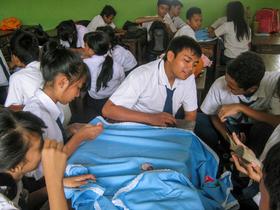Top Rankings
Powers School District 31 ranks among the top 20% of public school district in Oregon for:
Category
Attribute
Student Attention
Lowest student-teacher ratio (Top 1%)
For the 2025-26 school year, there are 2 public schools serving 117 students in Powers School District 31. This district's average testing ranking is 3/10, which is in the bottom 50% of public schools in Oregon.
Public Schools in Powers School District 31 have an average math proficiency score of 26% (versus the Oregon public school average of 31%), and reading proficiency score of 22% (versus the 44% statewide average).
Minority enrollment is 31% of the student body (majority American Indian), which is less than the Oregon public school average of 42% (majority Hispanic).
Overview
This School District
This State (OR)
# Schools
2 Schools
1,302 Schools
# Students
117 Students
541,703 Students
# Teachers
14 Teachers
29,489 Teachers
Student-Teacher Ratio
8:1
8:1
Student By Grade
District Rank
Powers School District 31, which is ranked within the bottom 50% of all 185 school districts in Oregon (based off of combined math and reading proficiency testing data) for the 2022-2023 school year.
The school district's graduation rate of 50% has stayed relatively flat over five school years.
Overall District Rank
#127 out of 187 school districts
(Bottom 50%)
(Bottom 50%)
Math Test Scores (% Proficient)
30%
31%
Reading/Language Arts Test Scores (% Proficient)
25-29%
44%
Science Test Scores (% Proficient)
≤20%
30%
Graduation Rate
(20-21)≥50%
81%
Students by Ethnicity:
Diversity Score
0.47
0.60
% American Indian
9%
1%
% Asian
n/a
4%
% Hispanic
n/a
26%
% Black
n/a
3%
% White
69%
58%
% Hawaiian
n/a
1%
% Two or more races
22%
7%
All Ethnic Groups
District Revenue and Spending
The revenue/student of $22,444 is higher than the state median of $18,279. The school district revenue/student has grown by 6% over four school years.
The school district's spending/student of $20,410 is higher than the state median of $19,325. The school district spending/student has grown by 6% over four school years.
Total Revenue
$3 MM
$9,902 MM
Spending
$2 MM
$10,468 MM
Revenue / Student
$22,444
$18,279
Spending / Student
$20,410
$19,325
Best Powers School District 31 Public Schools (2025-26)
School
(Math and Reading Proficiency)
(Math and Reading Proficiency)
Location
Quick Facts
Rank: #11.
Powers Elementary School
(Math: 21-39% | Reading: 20-29%)
Rank:
Rank:
3/
Bottom 50%10
Poplar St
Powers, OR 97466
(541) 439-2281
Powers, OR 97466
(541) 439-2281
Gr: K-6 | 63 students Student-teacher ratio: 9:1 Minority enrollment: 30%
Rank: #22.
Powers High School
(Math: ≤20% | Reading: ≤20%)
Rank:
Rank:
2/
Bottom 50%10
High School Hill Rd
Powers, OR 97466
(541) 439-2291
Powers, OR 97466
(541) 439-2291
Gr: 7-12 | 54 students Student-teacher ratio: 8:1 Minority enrollment: 32%
Frequently Asked Questions
How many schools belong to Powers School District 31?
Powers School District 31 manages 2 public schools serving 117 students.
What is the rank of Powers School District 31?
Powers School District 31 is ranked #144 out of 185 school districts in Oregon (bottom 50%) based off of combined math and reading proficiency testing data for the 2022-2023 school year. This district ranks in the top 20% of Oregon school districts for: Lowest student-teacher ratio (Top 1%)
What is the racial composition of students in Powers School District 31?
69% of Powers School District 31 students are White, 22% of students are Two or more races, and 9% of students are American Indian.
What is the student/teacher ratio of Powers School District 31?
Powers School District 31 has a student/teacher ratio of 8:1, which is lower than the Oregon state average of 18:1.
What is Powers School District 31's spending/student ratio?
The school district's spending/student of $20,410 is higher than the state median of $19,325. The school district spending/student has grown by 6% over four school years.
Recent Articles

School Vouchers: Updated Pros and Cons (2025 Review)
Comprehensive 2025 analysis of school vouchers, weighing benefits and challenges for families, funding, outcomes, and policy directions.

Benefits and Drawbacks of Homework in 2025
Explore updated 2025 insights on homework鈥檚 benefits, drawbacks, mental health impact, best practices, and policy trends in U.S. public schools.

Charter Schools vs Public Schools 2025: Key Differences & Trends
Explore updated 2025 insights comparing charter schools vs public schools, enrollment, academic outcomes, funding, and real-world examples for families and educators.





